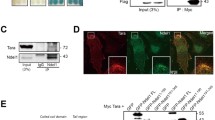Abstract
Dynamic remodeling of the actin cytoskeleton is crucial for biological processes such as cell migration and cell spreading. S100A10 is a member of the S100 protein family and is involved in intracellular trafficking and cell migration. In this study, we examined the role of S100A10 in actin cytoskeletal organization and cell spreading. Depletion of S100A10 induced disruption of stress fiber formation and delay in cell spreading. Rac1 activation during spreading was suppressed by S100A10 knockdown, and exogenous expression of active Rac1 restored the ability of cells to spread in the absence of S100A10. Our results demonstrate the crucial role of S100A10 in actin dynamics promoting cell spreading via Rac1 activation.




Similar content being viewed by others
References
Raftopoulou M, Hall A (2004) Cell migration: Rho GTPases lead the way. Dev Biol 265:23–32
Ridley AJ (2006) Rho GTPases and actin dynamics in membrane protrusions and vesicle trafficking. Trends Cell Biol 16:522–529
Urban E, Jacob S, Nemethova M, Resch GP, Small JV (2012) Small, electron tomography reveals unbranched networks of actin filaments in lamellipodia. Nat Cell Biol 12:429–435
Parri M, Chiarugi P (2010) Rac and Rho GTPases in cancer cell motility control. Cell Commun Signal 8:23
Ito S, Takahara Y, Hyodo T, Hasegawa H, Asano E, Hamaguchi M, Senga T (2010) The roles of two distinct regions of PINCH-1 in the regulation of cell attachment and spreading. Mol Biol Cell 21:4120–4129
Rescher U, Gerke V (2008) S100A10/p11: family, friends and functions. Pflugers Arch 455:575–582
Donato R (2001) S100: a multigenic family of calcium-modulated proteins of the EF-hand type with intracellular and extracellular functional roles. Int J Biochem Cell Biol 33:638–668
Marenholz I, Heizmann CW, Fritz G (2004) S100 proteins in mouse and man: from evolution to function and pathology (including an update of the nomenclature). Biochem Biophy Res Commun 322:1111–1122
Salama I, Malone PS, Mihaimeed F, Jones JL (2007) A review of the S100 proteins in cancer. Eur J Surg Oncol 34:357–364
Donato R, Cannon BR, Sorci G, Riuzzi F, Hsu K, Weber DJ, Geczy CL(2012) Functions of S100 proteins. Curr Mol Med (in press)
Réty S, Sopkova J, Renouard M, Osterloh D, Gerke V, Tabaries S, Russo-Marie F, Lewit-Bentley A (1999) The crystal structure of a complex of p11 with the annexin II N-terminal peptide. Nat Struct Biol 6:89–95
Gerke V, Weber K (1985) The regulatory chain in the p36-kd substrate complex of viral tyrosine-specific protein kinases is related in sequence to the S-100 protein of glial cells. EMBO J 4:2917–2920
Rust R, Visser L, van der Leij J, Harms G, Blokzijl T, Deloulme JC, van der Vlies P, Kamps W, Kok K, Lim M, Poppema S, van den Berg A (2005) High expression of calcium-binding proteins, S100A10, S100A11 and CALM2 in anaplastic large cell lymphoma. Br J Haematol 131:596–608
Ito Y, Arai K, Nozawa R, Yoshida H, Higashiyama T, Takamura Y, Miya A, Kobayashi K, Kuma K, Miyauchi A (2007) S100A10 expression in thyroid neoplasms originating from the follicular epithelium: contribution to the aggressive characteristic of anaplastic carcinoma. Anticancer Res 27:2679–2683
Liu J, Li X, Dong GL, Zhang HW, Chen DL, Du JJ, Zheng JY, Li JP, Wang WZ (2008) In silico analysis and verification of S100 gene expression in gastric cancer. BMC Cancer 8:261
Jhung MJ, Murzik U, Wehder L, Hemmerich P, Melle C (2010) Regulation of cellular actin architecture by S100A10. Exp Cell Res 316:1234–1240
McKeirnan E, McDermott EW, Evoy D, Crown J, Duffy MJ (2011) The role of S100 genes in breast cancer progression. Tumour Biol 32:441–450
Thiel C, Osborn M, Gerke V (1992) The tight association of the tyrosine kinase substrate annexin II with the submembranaous cytoskeleton depends on intact p11- and Ca(2+)-binding sites. J Cell Sci 103:733–742
Zobiack N, Gerke V, Rescher U (2001) Complex formation and submembranous localization of annexin 2 and S100A10 in live HepG2 cells. FEBS Lett 500:137–140
Lewit-Bentley A, Rety S, Sopkova-de Oliveira Santos J, Gerke V (2000) S100-annexin complexes: some insights from structural studies. Cell Biol Int 24:799–802
Harder T, Gerke V (1993) The subcellular distribution of early endosomes is affected by the annexin ll2p11(2) complex. J Cell Biol 123:1119–1132
Grieve AG, Moss SE, Hayes MJ (2012) Annexin A2 at the interface of actin and membrane dynamics: a focus on its roles in endocytosis and cell polarization. Int J Cell Biol 2012:852430
Hayes MJ, Rescher U, Gerke V, Moss SE (2004) Annexin-actin interaction. Traffic 8:571–576
Hayes MJ, Shao D, Bailly M, Moss SE (2006) Regulation of actin dynamics by annexin 2. EMBO J 25:1816–1826
Babbin BA, Parkos CA, Mandell KJ, Winfree LM, Laur O, Ivaov AL, Nusrat A (2007) Annexin 2 regulates intestinal epithelial cell spreading and wound closure through Rho-related signaling. Am J Pathol 170:951–966
Hall A (2005) Rho GTPases and the control of cell behaviour. Biochem Soc Trans 33:891–895
Price LS, Leng J, Schwartz MA, Bokoch GM (1998) Activation of Rac and Cdc42 by integrins mediates cell spreading. Mol Biol Cell 9:1863–1871
Sepulveda JL, Wu C (2006) The parvins. Cell Mol Life Sci 63:25–35
Amano M, Nakayama M, Kaibuchi K (2010) Rho-kinase/ROCK: a key regulator of the cytoskeleton and cell polarity. Cytoskeleton 67:545–554
Pellegrin S, Mellor H (2007) Actin stress fibres. J Cell Sci 120:3491–3499
Acknowledgments
We would like to thank the members of the Division of Cancer Biology for helpful discussions. We gratefully acknowledge Dr. Kaibuchi (Department of Cell Pharmacology, Nagoya University Graduate School of Medicine) for providing RhoA and Rac1 plasmids and for technical assistance. This research was partially funded by a Grant from the Ministry of Education, Culture, Sports, Science and Technology of Japan.
Author information
Authors and Affiliations
Corresponding author
Rights and permissions
About this article
Cite this article
Sayeed, S., Asano, E., Ito, S. et al. S100A10 is required for the organization of actin stress fibers and promotion of cell spreading. Mol Cell Biochem 374, 105–111 (2013). https://doi.org/10.1007/s11010-012-1509-2
Received:
Accepted:
Published:
Issue Date:
DOI: https://doi.org/10.1007/s11010-012-1509-2




